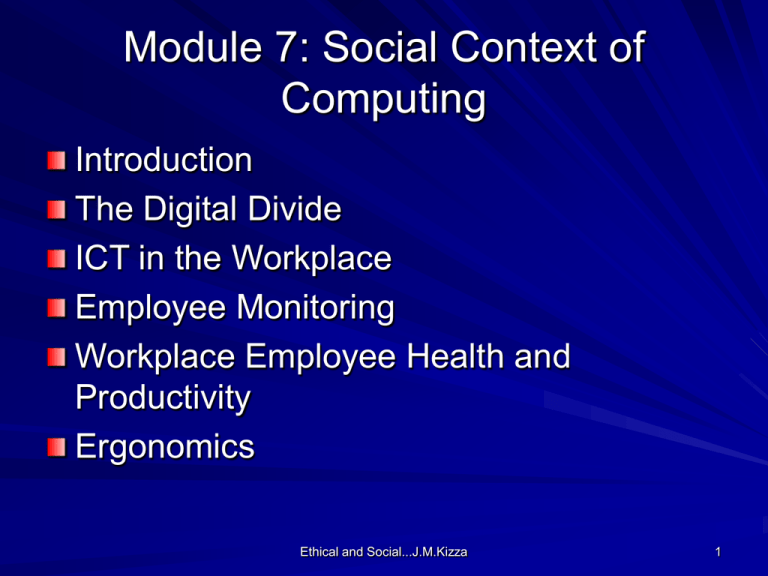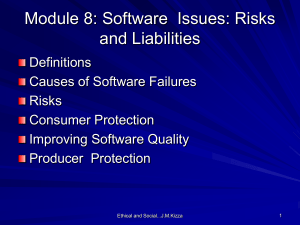Abstract View of System Components
advertisement

Module 7: Social Context of Computing Introduction The Digital Divide ICT in the Workplace Employee Monitoring Workplace Employee Health and Productivity Ergonomics Ethical and Social...J.M.Kizza 1 In the last fifty years we have witnessed an invasion of the workplace, homes, and mostly schools by computers and computer related equipment. Playing this double role as an utility and entertainment tool, the computer has become an integral part of our social fabric Ever since the beginning of the industrial age when technology started entering the workplace and homes, the aim has been to utilize it and help make us wiser and more productive Ethical and Social...J.M.Kizza 2 We spend more time in the workplace Domesticated technology to improve workplace Since the industrial age, the workplace has been in the forefront of technological innovation The fears that technology will replace workers, which have been the main force behind the resistance to workplace modernization have not materialized Every new technology brings new workers in the workspace Ethical and Social...J.M.Kizza 3 The Digital Divide Communication technological inequalities among peoples in one country and between countries, commonly known as the digital divide, sprung out of the 1994 landmark U.S Commerce Department’s study The debate has centered on a number of key critical issues including: – whether there is such a thing as a digital divide, – indicators that should be used to measure such a divide if it exists, and – the best ways to close such a divide. In general, the study of the digital divide involves the study of the impact on society’s social, economic, political, and cultural institutions by communication technologies such as : radio, television, the press, post offices, fixed and cellular telephones, fax machines, airports, computers, and connectivity to the Internet Ethical and Social...J.M.Kizza 4 There are five indicators of the digital divide namely: access, technology, humanware (human capacity), infrastructure, and enabling environment. Access – Presents obstacles which can broadly be grouped into five categories: – geography, – income, – ethnicity, – age, and – education. Ethical and Social...J.M.Kizza 5 Technology -The computer-driven technological revolution has brought the countries of the world ever closer together but it also divided countries Technologies like faxes, cellular phones, computers and Internet connections registered almost zero growth per thousand people in developing countries in comparison to their counterparts in the developed countries during the same period. A good technological base depends a great deal on relevant inputs: – investment capital, – infrastructure, and – humanware(human capacity). Ethical and Social...J.M.Kizza 6 Humanware (Human Capacity ) - The availability and easy access to ICT does not always solve the digital divide problem. – lack of humanware, in developing counties to maintain the equipment - shortage of teachers, technicians and institutes to train them. – challenge to ensure that people can gainfully use ICT to add value to local inputs. People will take ICT seriously when it meets and serves their own local Ethical and Social...J.M.Kizza 7 Human capacity development is a complex multifaceted endeavor consisting of many parts including: – creating awareness of the potential for ICT to meet one's needs – creating, developing, and strengthening capacity to use information and ICT effectively using local inputs. – Building capacity to produce and package information so that it adds value to local inputs. – Ensuring ongoing technical capacity development, and developing a format for knowledge and information sharing. – Preventing the local capacity from being drained to other, usually, developed countries. Ethical and Social...J.M.Kizza 8 Infrastructure -As noted by many, the digital divide infrastructure is related to access in many ways. They both present obstacles to gaining access to ICT. Fixed communication structures. In those countries with good fixed communication structures like electricity, telephones, good roads, and airports, ICT development is a lot faster. Lack of such resources hinders the development of ICT Enabling Environments - there are many countries with similar levels of per capita incomes and economic structures exhibiting widely varying ICT performances. There are no good explanations for this except that of enabling environments or lack of. An ICT enabling environment is an environment in which ICT can thrive. There are several things that can bring about such an environment, including politics and public policy and management styles. – – – – Politics - ICT thrives in a good political environment that ensures: a climate of democratic rights and civil liberties conducive to ICT adaptation respect for the rule of law and security of property rights investment in human capacity, and low level of government distortions Ethical and Social...J.M.Kizza 9 Public Policy and Management Styles Governments must put in place streamlined regulatory policies for importation and licensing of ICT technologies. Laws must be enacted and uniformly enforced so that nongovernmental organizations (NGOs) and other organizations interested in investing in ICT economic activities do so with ease Ethical and Social...J.M.Kizza 10 The Changing Workplace The workplace can be anywhere where one performs tasks: – – – – A place away from home In a car/plane/train Home Virtual office In the home office: – Categories of workers have been changing – Company benefits are mixed – Not everyone benefits from home-based work Ethical and Social...J.M.Kizza 11 The Changing Workplace… There are company fears arising from homebased work: – – – – Trade secrets Supervision Productivity Liability Unstudied social and Ethical effects: – Psychological – Social Ethical and Social...J.M.Kizza 12 Employee Monitoring The purpose of workspace monitoring Types of monitoring: – Electronic – Video Benefits of monitoring: – Good management, performance evaluation, management control, accurate assessment, immediate feedback and, flexible work assignments. Ethical and Social...J.M.Kizza 13 Workplace Privacy and Surveillance… Effects of electronic monitoring: Reduced task variety Lack of individual initiatives Reduced or no peer social support Lack of self-esteem Lack of interest in the job Lack of trust among workers, between workers and supervisors, and between supervisors and management Alienation Ethical and Social...J.M.Kizza 14 Computer-related Risks Employee safety Reliability System safety and security Individual privacy. Ethical and Social...J.M.Kizza 15 Employee Health and Productivity Ergonomics- an applied science concerned with the human-machine interactions that offer and maintain the safety, comfort, health, and habitable environment. Ergonomic injuries result when demand on an employee to perform far exceeds that person’s working capacity Ethical and Social...J.M.Kizza 16 Employee Health and Productivity… Ergonomic-related musculosketal disorder such as: – – – – Back pain Neck and shoulder pains Repetitive strain injuries (RSI) Stress Productivity of workers depends on their health Companies are getting the message and are forming health clubs, day-care centers on company premises, and offering extended maternity leaves Ethical and Social...J.M.Kizza 17











